微波水热合成钛酸钡纳米粉体_陈杰
单分散纳米钛酸钡晶体的微波水热合成与表征_推荐一个研究型综合实验
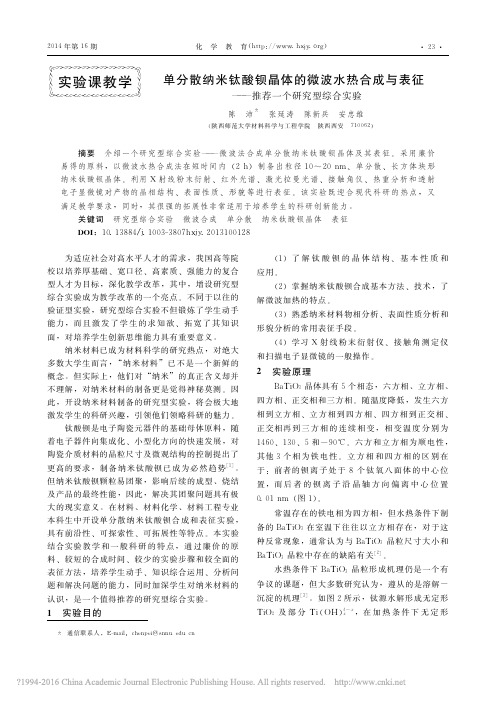
水热 条 件 下 BaTiO3 晶 粒 形 成 机 理 仍 是 一 个 有 争议的课题,但大多数研究认为,遵从的是溶解- 沉淀的机理 。 [3] 如图2所示,钛源水解形成无 定 形
TiO2
及部分
Ti(OH
)4-x x
,
在
加
热
条
件
下
无
定
形
* 通信联系人,E-mail:chenpei@snnu.edu.cn
关键词 研究型综合实验 微波合成 单分散 纳米钛酸钡晶体 表征 DOI:10.13884/j.1003-3807hxjy.2013100128
为适应社会对高水平人才的需求,我国高等院 校以培养厚基础、宽口径、高素质、强能力的复合 型人才为目标,深化教学改革,其中,增设研究型 综合实验成为教学改革的一个亮点。不同于以往的 验证型实验,研究型综合实验不但锻炼了学生动手 能力,而 且 激 发 了 学 生 的 求 知 欲、 拓 宽 了 其 知 识 面,对培养学生创新思维能力具有重要意义。
5 产 物 表 征
采用 X 射 线 粉 末 衍 射 仪 (XRD) 和 激 光 拉 曼 光谱仪对产物的晶体结构进行表征;利用红外光谱 仪 (IR)、热 失 重 分 析 (TG) 和 接 触 角 测 试 研 究 油酸分子在钛酸钡表面的包覆作用;利用透射电子 显微镜 (TEM) 和 高 分 辨 TEM 观 察 产 物 的 晶 体 形貌和晶格。 5.1 晶 体 结 构 表 征
室温下,立方相钛酸钡是拉曼惰性的,而四方 相钛酸钡是拉曼活性的,故拉曼光谱可灵敏地检测 四方 相 的 存 在。 从 图 3 (b) 可 以 看 出, 在 183、 261、305、520、715cm-1 出 现 了 拉 曼 峰, 其 中 305cm-1和715cm-1 是 四 方 相 钛 酸 钡 的 典 型 拉 曼 特征峰 。 [4] 这说 明 所 合 成 的 钛 酸 钡 主 相 为 立 方 相, 同时存在少量四方相。
溶胶-凝胶微波辅助水热处理合成纳米TiO2
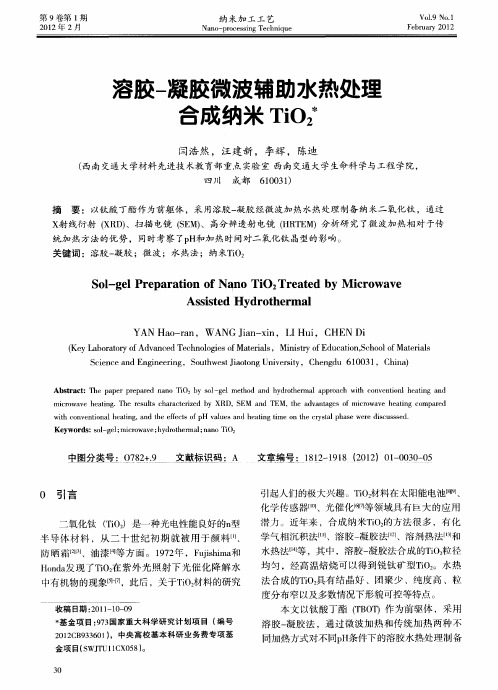
半导体材料 ,从二 十世 纪初期就被用 于颜料_ l 1 、 防晒霜IJ 、油漆 等方面 。17 年 ,Fj h a 92 u si 和 i m H na od 发现 了TO在 紫外光 照射下光催 化降解水 i 中有机物的现象[ 5 ,此后 ,关于TO材料的研究 1 - [ i
金 项 目 (WJU1C 0 8 o S T 1X 5
第 1 期 21年 2 02 月
纳 米 科 技
Na o ce e & Na o e h l g n s inc n t c noo y
关键词 :溶胶 一 凝胶 ;微 波 ;水热 法 ;纳米TO i。
S l e e a a i n o no Ti e t d b ir wa e o -g lPr p r to fNa O2 Tr a e y M c o v Asit d dr t e m a sse Hy o h r l
闫浩然 ,汪建新 ,李辉 ,陈迪
( 西南交通大学材料先进技术教育部重点实验室 西南交通大学生命科学与工程学院,
四 川 成都 60 3) 10 1
摘
要 :以钛 酸 丁酯作 为前躯 体 ,采 用溶胶 一 凝胶 经微 波加 热 水热 处理 制备 纳 米二 氧化钛 ,通过
x 线衍射 (R ) 射 X D 、扫描 电镜 (E 、 高分辨 透射 电镜 ( T M)分析 研 究 了微 波加热 相 对 于传 S M) HR E 统加 热方 法的优 势 , 同时考察 了p 和 加热 时 间对二氧化 钛 晶型 的影响 。 H
收 稿 日期 :0 1 1— 9 2 1- 0 0 基 金 项 目 :7 国 家 重 大 科 学 研 究计 划 项 目 ( 号 93 编
微波—水热法合成纳米钛酸钡原料
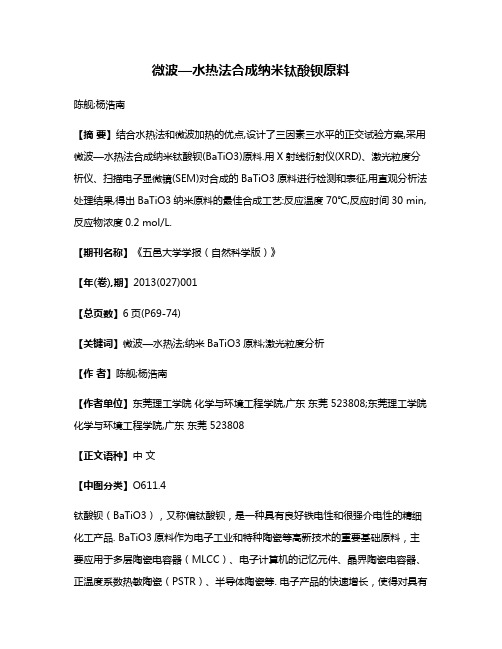
微波—水热法合成纳米钛酸钡原料陈舰;杨浩南【摘要】结合水热法和微波加热的优点,设计了三因素三水平的正交试验方案,采用微波—水热法合成纳米钛酸钡(BaTiO3)原料.用X射线衍射仪(XRD)、激光粒度分析仪、扫描电子显微镜(SEM)对合成的BaTiO3原料进行检测和表征,用直观分析法处理结果,得出BaTiO3纳米原料的最佳合成工艺:反应温度70℃,反应时间30 min,反应物浓度0.2 mol/L.【期刊名称】《五邑大学学报(自然科学版)》【年(卷),期】2013(027)001【总页数】6页(P69-74)【关键词】微波—水热法;纳米BaTiO3原料;激光粒度分析【作者】陈舰;杨浩南【作者单位】东莞理工学院化学与环境工程学院,广东东莞 523808;东莞理工学院化学与环境工程学院,广东东莞 523808【正文语种】中文【中图分类】O611.4钛酸钡(BaTiO3),又称偏钛酸钡,是一种具有良好铁电性和很强介电性的精细化工产品. BaTiO3原料作为电子工业和特种陶瓷等高新技术的重要基础原料,主要应用于多层陶瓷电容器(MLCC)、电子计算机的记忆元件、晶界陶瓷电容器、正温度系数热敏陶瓷(PSTR)、半导体陶瓷等. 电子产品的快速增长,使得对具有更小粒径、更高纯度、形貌均匀的BaTiO3原料的需求量越来越大.目前BaTiO3原料的合成方法主要有固相烧结法、化学沉淀法、溶胶凝胶法、微乳液法、水热合成法等. 与传统合成法相比,微波—水热法在很多方面表现出了优势,如瞬间使物体整体温度达到结晶化温度,沉淀凝胶快速溶解均匀成核并迅速达到饱和,结晶化时间缩短[1]. 微波—水热法合成BaTiO3的影响因素有:溶液pH值[2]、反应时间[3]、钡钛比例[4]、反应温度[5]、分散剂[5]等,但最佳工艺参数还在探索中. 本文选用钛酸丁酯和硝酸钡Ba(NO3)2为原料,NaOH为矿化剂,设计三因素三水平的正交试验方案,寻找用微波—水热法制备BaTiO3原料的最佳工艺条件.:化学纯,天津市光复精细化工研究所;Ba(NO3)2:分析纯,天津市福晨化学试剂厂;NaOH:分析纯,汕头市西陇化工厂有限公司;无水乙醇:分析纯,天津市大茂化学试剂厂;冰醋酸:分析纯,天津市大茂化学试剂厂.微波固相合成仪:T640,莱伯泰科有限公司;恒温磁力搅拌器:81-2,上海司乐仪器厂;电子天平:FA2004,上海舜宇恒平科学仪器有限公司;电热鼓风恒温干燥箱:101-1A,上海讯能电热设备有限公司;X射线衍射仪:UItima IV,日本理学株式会社;激光粒度分析仪:RISE-2008,济南润之科技有限公司;扫描电子显微镜:JSM-7600F,日本电子株式会社.1.2 实验操作1)将Ba(NO3)2溶于蒸馏水,配制成0.3 mol/L的Ba(NO3)2溶液;将溶于无水乙醇,配制成0.3 mol/L的溶液;将NaOH溶于蒸馏水,配制成2 mol/L的溶液.2)取100 mLNaOH溶液加热至80℃,冷却至室温,在恒温磁力搅拌下,逐滴加入100 mL 溶液,最后加入100 mL Ba(NO3)2溶液. 混合均匀后,用pH试纸检测pH值(>13). 将乳白液倒入反应釜中,设置好反应时间和反应温度,在微波固相合成仪中反应.3)反应结束后,将反应液抽滤,再依次用稀醋酸酸洗、水洗、醇洗. 所得固体用烘箱在85℃下烘6 h,得到白色原料.4)分别控制反应物Ba(NO3)2和浓度为0.2 mol/L、0.3 mol/L、0.4 mol/L,反应温度为70℃、85℃、90℃,反应时间为10 min、30 min、40 min,重复上述三步骤,制备9种条件下的9个产物并编号.5)X射线衍射仪实验条件:Cu靶,工作电压40 kV,工作电流40 mA.2 结果与分析控制钡钛物质的量之比为1:1,溶液pH≥13,干燥时间和干燥温度(85℃)一定,做9组实验,用X射线衍射仪对合成原料进行晶相检测,用激光粒度分析仪测量粉体颗粒的粒度,用扫描电子显微镜扫描合成BaTiO3原料的表面形貌,用直观分析法对样品进行分析,找出最佳工艺参数.2.1 实验正交方案综合郭立童[3]、赵艳敏[5]等人的文献,本文选择反应温度、反应时间、反应物浓度作为正交试验方案的三个因素,具体见表1.表1 试验因素水平因素反应温度/℃反应时间/min反应物浓度/() 170100.2 285300.3 390400.42.2 9个产物样品的晶面间距XRD是鉴定物质晶像、研究晶体结构快速有效的方法. 从9个样品的XRD谱图可以看出:1)9个样品的XRD图谱与标准卡片PDF Card NO:00-031-0174立方相BaTiO3相比,其衍射角及相对应的衍射强度基本一致,由此可以确定合成的原料主晶相为立方相BaTiO3. 2)9个样品的谱图基准线都比较粗糙,除2号样外,其他谱图还出现了明显的杂峰,这表明2号样品的结晶纯度最高、杂质含量最少. BaTiO3原料烧结后活性更高,其介电性能和压电性能也大大提高. 晶面间距是衡量BaTiO3原料是否合格的重要指标,晶面间距小符合BaTiO3原料高纯细的追求. 晶面间距越小,说明BaTiO3晶体分布越窄. 通过XRD谱图生成的报告可以得到9个合成样品晶体(110)面的晶面间距,见表2.表2 样品的晶面间距样品编号反应条件晶面间距/ang 反应温度/℃反应时间/min 反应物浓度/() 11(70)1(10)2(0.3)3.69 21(70)2(30)1(0.2)2.85 31(70)3(40)3(0.4)2.33 42(85)1(10)3(0.4)3.71 52(85)2(30)2(0.3)3.69 62(85)3(40)1(0.2)3.69 73(90)1(10)1(0.2)2.87 83(90)2(30)3(0.4)2.34 93(90)3(40)2(0.3)2.85从表3反应条件的极差R值可以看出,对晶面间距而言,反应温度的极差最大,其次是反应物浓度,最次是反应时间. 所以,微波—水热法合成BaTiO3原料的最佳工艺条件:反应温度70 ℃,反应时间30 min,反应物浓度0.2 mol/L.表3 极差分析极差晶面间距反应温度反应时间反应物浓度 K108.8710.2709.41K211.0909.3910.23 K308.0608.8708.38 R102.9603.4203.14R204.0003.1303.41 R302.6902.9602.79 极差01.3100.4600.622.3 最佳工艺产品的检验2.3.1 粒度本文采用激光粒度分析仪测量微波—水热法在最佳工艺条件下合成原料的粉体颗粒粒度(图1),并与市售标准品的粉体颗粒粒度(图2)对比.图1 最佳工艺合成粉体的粒度分布图图2 市售标准品粒度分布图从图1和图2可以看出:1)微波—水热法最佳工艺条件下合成的BaTiO3粉体平均颗粒粒度为0.967 μm,比市售标准品的平均颗粒粒度(2.337 μm)小2.4倍左右. 2)微波—水热法最佳工艺条件下合成的BaTiO3粉体的粒径分布比市售标准品的分布宽,说明合成的样品拥有更细的粒径,但是粒径大小分布的均匀性还有待提高.2.3.2 表面形貌和晶体尺寸SEM常用来观察样品表面形貌(断口等),本文采用SEM来测试最佳工艺条件下合成粉体的表面形貌和晶体尺寸,并与其他条件下的2个样品作对比,具体见图3、4、5.图3的晶体为梭子形,原料的平均粒径在0.74 μm左右,形貌模糊,图形不规则,结晶纯度低. 图4的晶体中出现大圆球,有明显的团聚现象,表明原料质量较差.图5的晶体形状为球形,颗粒分布均匀,没有团聚现象,晶体直径平均在50 nm,其表面形貌和晶体尺寸比较理想.图3 反应温度70℃,反应时间10 min,反应物浓度0.3 mol/L的SEM图图4 反应温度70℃,反应时间40 min,反应物浓度0.4 mol/L的SEM图图5 最佳工艺粉体的SEM图2.4 讨论相比传统工艺,微波—水热法显示出了明显的优势,具体见表4.表4 不同工艺的粒径比较工艺反应温度/℃反应时间/min粒径/nm 本文的微波—水热法07003050左右罗昆鹏[2]的微波水热法07001060~100 赵艳敏[6]等人的传统水热法24048060~100 全学军[7]等人的草酸络合物沉淀法800060540 续京[8]等人的化学沉淀法080060803 结论本实验采用微波—水热法合成纳米BaTiO3原料的最佳工艺参数为:反应温度70 ℃,反应时间30 min,反应物浓度0.2 mol/L. 相比于传统工艺,微波—水热法更具优势,如加热速度快、反应温度低、反应时间短、反应条件更容易达到,合成产物的粒径更细、分散性好、表面形貌更均匀.参考文献[责任编辑:熊玉涛]Nano-BaTiO3 Raw Materials Synthesized by Microwave-hydrothermal MethodCHEN Jian, YANG Hao-nan(College of Chemistry and Environmental Engineering, Dongguan University of Technology,Dongguan 523808, China)Abstract: With the advantages of the hydrothermal method and microwave heating method, Barium Titanium Oxide (BaTiO3) raw materials are synthesized by using microwave-hydrothermal method. Threefactors with three levelsare considered in the experiment, thesyntheticpowders are tested and characterized via usingX-raydiffraction(XRD), laser particle size analysis instrument and scanning electronmicroscopy (SEM). Intuitiveanalysis is adopted to detect the experiment results, theoptimal parameters for Barium Titanium Oxide (BaTiO3) raw materials synthesizing is concluded:reaction temperature is 70 ℃,reaction time is 30 min, reactant concentration is 0.2 mol/L.Key words: microwave-hydrothermal method; nano-BaTiO3 raw materials; laser particle size analysis文章编号:1006-7302(2013)01-0069-06中图分类号:O611.4文献标志码:A收稿日期:2012-11-05作者简介:陈舰(1955—),男,四川自贡人,副教授,主要从事无机非金属材料的研究.微波固相合成仪:T640,莱伯泰科有限公司;恒温磁力搅拌器:81-2,上海司乐仪器厂;电子天平:FA2004,上海舜宇恒平科学仪器有限公司;电热鼓风恒温干燥箱:101-1A,上海讯能电热设备有限公司;X射线衍射仪:UItima IV,日本理学株式会社;激光粒度分析仪:RISE-2008,济南润之科技有限公司;扫描电子显微镜:JSM-7600F,日本电子株式会社.1)将Ba(NO3)2溶于蒸馏水,配制成0.3 mol/L的Ba(NO3)2溶液;将溶于无水乙醇,配制成0.3 mol/L的溶液;将NaOH溶于蒸馏水,配制成2 mol/L的溶液.2)取100 mLNaOH溶液加热至80℃,冷却至室温,在恒温磁力搅拌下,逐滴加入100 mL 溶液,最后加入100 mL Ba(NO3)2溶液. 混合均匀后,用pH试纸检测pH值(>13). 将乳白液倒入反应釜中,设置好反应时间和反应温度,在微波固相合成仪中反应.3)反应结束后,将反应液抽滤,再依次用稀醋酸酸洗、水洗、醇洗. 所得固体用烘箱在85℃下烘6 h,得到白色原料.4)分别控制反应物Ba(NO3)2和浓度为0.2 mol/L、0.3 mol/L、0.4 mol/L,反应温度为70℃、85℃、90℃,反应时间为10 min、30 min、40 min,重复上述三步骤,制备9种条件下的9个产物并编号.5)X射线衍射仪实验条件:Cu靶,工作电压40 kV,工作电流40 mA.控制钡钛物质的量之比为1:1,溶液pH≥13,干燥时间和干燥温度(85℃)一定,做9组实验,用X射线衍射仪对合成原料进行晶相检测,用激光粒度分析仪测量粉体颗粒的粒度,用扫描电子显微镜扫描合成BaTiO3原料的表面形貌,用直观分析法对样品进行分析,找出最佳工艺参数.综合郭立童[3]、赵艳敏[5]等人的文献,本文选择反应温度、反应时间、反应物浓度作为正交试验方案的三个因素,具体见表1.XRD是鉴定物质晶像、研究晶体结构快速有效的方法. 从9个样品的XRD谱图可以看出:1)9个样品的XRD图谱与标准卡片PDF Card NO:00-031-0174立方相BaTiO3相比,其衍射角及相对应的衍射强度基本一致,由此可以确定合成的原料主晶相为立方相BaTiO3. 2)9个样品的谱图基准线都比较粗糙,除2号样外,其他谱图还出现了明显的杂峰,这表明2号样品的结晶纯度最高、杂质含量最少. BaTiO3原料烧结后活性更高,其介电性能和压电性能也大大提高. 晶面间距是衡量BaTiO3原料是否合格的重要指标,晶面间距小符合BaTiO3原料高纯细的追求. 晶面间距越小,说明BaTiO3晶体分布越窄. 通过XRD谱图生成的报告可以得到9个合成样品晶体(110)面的晶面间距,见表2.从表3反应条件的极差R值可以看出,对晶面间距而言,反应温度的极差最大,其次是反应物浓度,最次是反应时间. 所以,微波—水热法合成BaTiO3原料的最佳工艺条件:反应温度70 ℃,反应时间30 min,反应物浓度0.2 mol/L.2.3.1 粒度本文采用激光粒度分析仪测量微波—水热法在最佳工艺条件下合成原料的粉体颗粒粒度(图1),并与市售标准品的粉体颗粒粒度(图2)对比.从图1和图2可以看出:1)微波—水热法最佳工艺条件下合成的BaTiO3粉体平均颗粒粒度为0.967 μm,比市售标准品的平均颗粒粒度(2.337 μm)小2.4倍左右. 2)微波—水热法最佳工艺条件下合成的BaTiO3粉体的粒径分布比市售标准品的分布宽,说明合成的样品拥有更细的粒径,但是粒径大小分布的均匀性还有待提高.2.3.2 表面形貌和晶体尺寸SEM常用来观察样品表面形貌(断口等),本文采用SEM来测试最佳工艺条件下合成粉体的表面形貌和晶体尺寸,并与其他条件下的2个样品作对比,具体见图3、4、5.图3的晶体为梭子形,原料的平均粒径在0.74 μm左右,形貌模糊,图形不规则,结晶纯度低. 图4的晶体中出现大圆球,有明显的团聚现象,表明原料质量较差.图5的晶体形状为球形,颗粒分布均匀,没有团聚现象,晶体直径平均在50 nm,其表面形貌和晶体尺寸比较理想.相比传统工艺,微波—水热法显示出了明显的优势,具体见表4.本实验采用微波—水热法合成纳米BaTiO3原料的最佳工艺参数为:反应温度70 ℃,反应时间30 min,反应物浓度0.2 mol/L. 相比于传统工艺,微波—水热法更具优势,如加热速度快、反应温度低、反应时间短、反应条件更容易达到,合成产物的粒径更细、分散性好、表面形貌更均匀.【相关文献】[1] 马麦霞,张光霞. 微波水热合成Mn掺杂BaTiO3纳米原料[J]. 硅酸盐通报,2010, 29(1): 108.[2] 罗昆鹏,微波水热合成钛酸钡纳米原料[D]. 西安:西安科技大学,2009: 17-44.[3] 郭立童,罗宏杰,郭立芝. 钛酸钡粉体的微波水热合成[J]. 中国陶瓷,2005, 41(1): 13.[4] 吴东辉,施新宇,张海军. 草酸盐共沉淀法制备钛酸钡粉体研究[J]. 压电与声光,2009, 31(2): 252.[5] 赵艳敏,冯绣丽,王公应. 超细钛酸钡粉体的水热合成[J]. 合成化学,2005, 13(3): 301-303.[6] 赵艳敏,王越,王公应. 纳米钛酸钡的水热合成进展[J]. 合成化学,2003(4): 300-306.[7] 全学军,李大成. 草酸络合物沉淀法制备超细钛酸钡粉的研究[J]. 四川大学学报,2001, 33(4):80-81.[8] 续京,张炎. 化学沉淀法制备纳米钛酸钡粉体[J]. 广西大学学报:自然科学版,2011(3): 445-449.。
水热法制备BaTO3纳米粉体
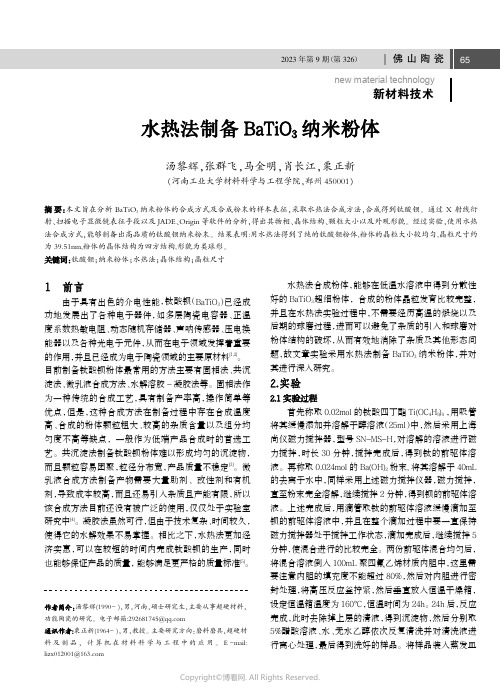
汤黎辉,张群飞,马金明,肖长江,栗正新(河南工业大学材料科学与工程学院,郑州450001)BaTiO 3纳米粉体的合成方式及合成粉末的样本表征,采取水热法合成方法,合成得到钛酸钡。
通过X 射线衍射、扫描电子显微镜表征手段以及JADE 、Origin 等软件的分析,得出其物相、晶体结构、颗粒大小以及外观形貌。
经过实验,使用水热法合成方式,能够制备出高品质的钛酸钡纳米粉末。
结果表明:用水热法得到了纯的钛酸钡粉体,粉体的晶粒大小较均匀,晶粒尺寸约为39.51nm,粉体的晶体结构为四方结构,形貌为类球形。
;纳米粉体;水热法;晶体结构;晶粒尺寸由于具有出色的介电性能,钛酸钡(BaTiO 3)已经成功地发展出了各种电子器件,如多层陶瓷电容器、正温度系数热敏电阻、动态随机存储器、声呐传感器、压电换能器以及各种光电子元件,从而在电子领域发挥着重要的作用,并且已经成为电子陶瓷领域的主要原材料[1,2]。
目前制备钛酸钡粉体最常用的方法主要有固相法、共沉淀法、微乳液合成方法、水解溶胶-凝胶法等。
固相法作为一种传统的合成工艺,具有制备产率高,操作简单等优点,但是,这种合成方法在制备过程中存在合成温度高、合成的粉体颗粒粗大、较高的杂质含量以及组分均匀度不高等缺点,一般作为低端产品合成时的首选工艺。
共沉淀法制备钛酸钡粉体难以形成均匀的沉淀物,而且颗粒容易团聚,粒径分布宽,产品质量不稳定[3]。
微乳液合成方法制备产物需要大量助剂、改性剂和有机剂,导致成本较高,而且还易引入杂质且产能有限,所以该合成方法目前还没有被广泛的使用,仅仅处于实验室研究中[4]。
凝胶法虽然可行,但由于技术复杂、时间较久,使得它的水解效果不易掌握。
相比之下,水热法更加经济实惠,可以在较短的时间内完成钛酸钡的生产,同时也能够保证产品的质量,能够满足更严格的质量标准[5]。
水热法合成粉体,能够在低温水溶液中得到分散性好的BaTiO 3超细粉体,合成的粉体晶粒发育比较完整,并且在水热法实验过程中,不需要经历高温的煅烧以及后期的球磨过程,进而可以避免了杂质的引入和球磨对粉体结构的破坏,从而有效地消除了杂质及其他形态问题,故文章实验采用水热法制备BaTiO 3纳米粉体,并对其进行深入研究。
水热法合成钛酸钡
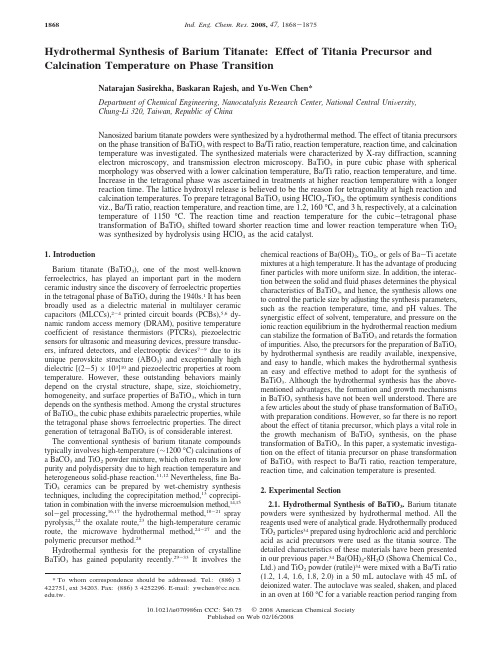
Hydrothermal Synthesis of Barium Titanate:Effect of Titania Precursor and Calcination Temperature on Phase TransitionNatarajan Sasirekha,Baskaran Rajesh,and Yu-Wen Chen*Department of Chemical Engineering,Nanocatalysis Research Center,National Central Uni V ersity,Chung-Li320,Taiwan,Republic of ChinaNanosized barium titanate powders were synthesized by a hydrothermal method.The effect of titania precursorson the phase transition of BaTiO3with respect to Ba/Ti ratio,reaction temperature,reaction time,and calcinationtemperature was investigated.The synthesized materials were characterized by X-ray diffraction,scanningelectron microscopy,and transmission electron microscopy.BaTiO3in pure cubic phase with sphericalmorphology was observed with a lower calcination temperature,Ba/Ti ratio,reaction temperature,and time.Increase in the tetragonal phase was ascertained in treatments at higher reaction temperature with a longerreaction time.The lattice hydroxyl release is believed to be the reason for tetragonality at high reaction andcalcination temperatures.To prepare tetragonal BaTiO3using HClO4-TiO2,the optimum synthesis conditionsviz.,Ba/Ti ratio,reaction temperature,and reaction time,are1.2,160°C,and3h,respectively,at a calcinationtemperature of1150°C.The reaction time and reaction temperature for the cubic-tetragonal phasetransformation of BaTiO3shifted toward shorter reaction time and lower reaction temperature when TiO2was synthesized by hydrolysis using HClO4as the acid catalyst.1.IntroductionBarium titanate(BaTiO3),one of the most well-known ferroelectrics,has played an important part in the modern ceramic industry since the discovery of ferroelectric properties in the tetragonal phase of BaTiO3during the1940s.1It has been broadly used as a dielectric material in multilayer ceramic capacitors(MLCCs),2-4printed circuit boards(PCBs),5,6dy-namic random access memory(DRAM),positive temperature coefficient of resistance thermistors(PTCRs),piezoelectric sensors for ultrasonic and measuring devices,pressure transduc-ers,infrared detectors,and electrooptic devices7-9due to its unique perovskite structure(ABO3)and exceptionally high dielectric[(2-5)×103]10and piezoelectric properties at room temperature.However,these outstanding behaviors mainly depend on the crystal structure,shape,size,stoichiometry, homogeneity,and surface properties of BaTiO3,which in turn depends on the synthesis method.Among the crystal structures of BaTiO3,the cubic phase exhibits paraelectric properties,while the tetragonal phase shows ferroelectric properties.The direct generation of tetragonal BaTiO3is of considerable interest. The conventional synthesis of barium titanate compounds typically involves high-temperature(∼1200°C)calcinations of a BaCO3and TiO2powder mixture,which often results in low purity and polydispersity due to high reaction temperature and heterogeneous solid-phase reaction.11,12Nevertheless,fine Ba-TiO3ceramics can be prepared by wet-chemistry synthesis techniques,including the coprecipitation method,13coprecipi-tation in combination with the inverse microemulsion method,14,15 sol-gel processing,16,17the hydrothermal method,18-21spray pyrolysis,22the oxalate route,23the high-temperature ceramic route,the microwave hydrothermal method,24-27and the polymeric precursor method.28Hydrothermal synthesis for the preparation of crystalline BaTiO3has gained popularity recently.29-33It involves the chemical reactions of Ba(OH)2,TiO2,or gels of Ba-Ti acetate mixtures at a high temperature.It has the advantage of producing finer particles with more uniform size.In addition,the interac-tion between the solid and fluid phases determines the physical characteristics of BaTiO3,and hence,the synthesis allows one to control the particle size by adjusting the synthesis parameters, such as the reaction temperature,time,and pH values.The synergistic effect of solvent,temperature,and pressure on the ionic reaction equilibrium in the hydrothermal reaction medium can stabilize the formation of BaTiO3and retards the formation of impurities.Also,the precursors for the preparation of BaTiO3 by hydrothermal synthesis are readily available,inexpensive, and easy to handle,which makes the hydrothermal synthesis an easy and effective method to adopt for the synthesis of BaTiO3.Although the hydrothermal synthesis has the above-mentioned advantages,the formation and growth mechanisms in BaTiO3synthesis have not been well understood.There are a few articles about the study of phase transformation of BaTiO3 with preparation conditions.However,so far there is no report about the effect of titania precursor,which plays a vital role in the growth mechanism of BaTiO3synthesis,on the phase transformation of BaTiO3.In this paper,a systematic investiga-tion on the effect of titania precursor on phase transformation of BaTiO3with respect to Ba/Ti ratio,reaction temperature, reaction time,and calcination temperature is presented.2.Experimental Section2.1.Hydrothermal Synthesis of BaTiO3.Barium titanate powders were synthesized by hydrothermal method.All the reagents used were of analytical grade.Hydrothermally produced TiO2particles34prepared using hydrochloric acid and perchloric acid as acid precursors were used as the titania source.The detailed characteristics of these materials have been presented in our previous paper.34Ba(OH)2‚8H2O(Showa Chemical Co., Ltd.)and TiO2powder(rutile)34were mixed with a Ba/Ti ratio (1.2,1.4,1.6,1.8,2.0)in a50mL autoclave with45mL of deionized water.The autoclave was sealed,shaken,and placed in an oven at160°C for a variable reaction period ranging from*To whom correspondence should be addressed.Tel.:(886)3422751,ext34203.Fax:(886)34252296.E-mail:ywchen@cc.ncu.edu.tw.1868Ind.Eng.Chem.Res.2008,47,1868-187510.1021/ie070986m CCC:$40.75©2008American Chemical SocietyPublished on Web02/16/20083to 24h.After cooling naturally to room temperature,the contents of the autoclave were diluted in 90mL of 0.1M formic acid with stirring for 5min in an attempt to remove any BaCO 3formed and the addition of excess Ba 2+to the starting solution.The mixture was filtered and washed with distilled water (500mL)three times,and the residue was dried in oven at 100°C for 24h.2.2.Characterization.The crystalline phase of BaTiO 3was analyzed by powder X-ray diffraction (XRD)using a Siemens D500automatic powder diffractometer.Nickel-filtered Cu K R radiation (λ)0.15418nm)was used with a generator voltage of 40kV and a current of 29mA.Bragg -Brentano focusing geometry was employed with an automatic divergence slit (irradiated sample length was 12.5nm),a receiving slit of 0.1nm,a fixed slit of 4°,and a proportional counter as a detector.It was operated in the step scan mode,at scanning speeds of 0.1°2θ/s and 1s step time in the range 20-80°for barium titanate.Scherrer’s equation 35was used to calculate the crys-tallite size of barium titanate crystals from the full width at half-maximum of the XRD peak.The morphology of the particles was analyzed by scanning electron microscopy (SEM)and transmission electron micros-copy (TEM).SEM images were acquired with a Hitachi S-800field emission microscope using an acceleration voltage of 20kV.The samples were coated with Au prior to analysis and imaged directly.TEM images were obtained on a JEOL JEM-2000FX Πmicroscope using an electron beam generated by a tungsten filament and an accelerating voltage of 160kV,a beam diameter of approximately 1-2µm,and an objective lens aperture of 20µm.The sample grids were prepared via sonication of powdered sample in ethanol for 10min and evaporating 1drop of the suspension onto a carbon-coated,porous film supported on a 3mm,200-300mesh copper grid.TEM images were recorded at a magnification of 100000-400000×.The magnification was calibrated in pixels per nanometer on the camera.3.Results and Discussion3.1.Effect of Ba/Ti Ratio.BaTiO 3powder,prepared with Ba/Ti ratio in the range of 1.2-2.0,was characterized by XRD,SEM,and TEM techniques to study the cubic -tetragonal phase transformations and surface modifications of BaTiO 3.The ratio of Ba/Ti was chosen to be greater than 1to avoid contamination of BaTiO 3(s)with excess TiO 2(s)under the conditions of hydrothermal synthesis.24Furthermore,Ba/Ti >1increases the pH of the solution,which is an important thermodynamicvariable for the synthesis of perovskite materials,and helps to avoid the addition of an alkaline mineralizer to facilitate the formation of BaTiO 3.According to the thermodynamic calcula-tions of stability diagrams for the hydrothermal Ba -Ti system,high pH and Ba/Ti >1are necessary for the synthesis of high-purity BaTiO 3crystals.28XRD patterns of the as-synthesized BaTiO 3,with Ba/Ti ratios of 1.2,1.4,1.6,1.8,and 2.0,showed the characteristic peaks of both cubic BaTiO 3(JCPDS File No.79-2263)and those of BaCO 3for both TiO 2precursors.Modest BaCO 3contamination was noted in almost all the samples due to the introduction of airborne CO 2,which would dissolve as CO 32-and reacts with Ba 2+to form BaCO 3during the posttreatment.26,36The formation of BaCO 3,observed in this work,is quite common in the hydrothermal processing as BaCO 3can precipitate at lower pH values than those needed to precipitate BaTiO 3.24AccordingtoFigure 1.XRD patterns of BaTiO 3synthesized at various Ba/Ti ratios using (a)HCl-TiO 2and (b)HClO 4-TiO 2precursors and washed with formic acid followed by calcination at 900°C (2h).Table 1.Effect of Ba/Ti Ratio and Calcination Temperature on the Crystalline Phase of BaTiO 3calcination temp (°C)Ti precursor Ba/Ti ratio synthesis temp (°C)synthesis time (h)9001150crystalline phase HCl-TiO 21.21606--cubic 1.41606--cubic 1.61606--cubic 1.81606--cubic2.01606--cubic HClO 4-TiO 21.21606--cubic 1.41606--cubic 1.61606--cubic 1.81606--cubic2.01606--cubic HCl-TiO 21.21606yes -cubic 1.41606yes -cubic 1.61606yes -cubic 1.81606yes -cubic2.01606yes -cubic HClO 4-TiO 21.21606yes -cubic 1.41606yes -cubic 1.61606yes -cubic 1.81606yes -cubic2.01606yes -cubic HCl-TiO 21.21606-yes cubic 1.41606-yes cubic 1.61606-yes cubic 1.81606-yes cubic2.01606-yes cubic HClO 4-TiO 21.21606-yes tetragonal 1.41606-yes tetragonal 1.61606-yes tetragonal 1.81606-yes tetragonal2.01606-yestetragonalInd.Eng.Chem.Res.,Vol.47,No.6,20081869the thermodynamic stability diagram of Ba -Ti systems,BaCO 3precipitates at lower pH values than those needed to precipitate BaTiO 3.28Moreover,the formation of BaCO 3is more predomi-nant in BaTiO 3prepared using HClO 4-TiO 2,which indicates its lower pH compared with those prepared using HCl-TiO 2.The relative pH of HClO 4is lower than that of HCl as the p K a values of HClO 4and HCl are -10and -7,respectively.37The XRD results of the as-synthesized BaTiO 3illustrate the absence of apparent peak splitting at 2θ)45°,which corre-sponds to the tetragonal phase of BaTiO 3(JCPDS Card No.5-0626)and hence confirmed the cubic structure with symmetry Pm 3m .In order to remove BaCO 3,the powders were washed with formic acid and calcined at 900°C for 2h.Figure 1shows XRD patterns of BaTiO 3chemically treated with formic acid and calcined at 900°C,which confirms the removal of BaCO 3from BaTiO 3prepared using HCl-TiO 2and HClO 4-TiO 2.Moreover,it indicates that there is no change in the cubic phase of BaTiO 3upon treatment with formic acid.The effect of Ba/Ti ratio and calcination temperature on the crystal structure of BaTiO 3is summarized in Table 1.It can be observed that,even at a Ba/Ti molar ratio of 2without heat treatment,the tetragonal splitting of the diffraction peaks corresponding to the (200)and (002)planes of the perovskite BaTiO 3could not be distinguished,indicating the presence of pure cubic crystalline phase.Shi et al.36observed tetragonal BaTiO 3crystallites when the precursor with high Ba/Ti molar ratio of 3was used,which reduces the probability of forming barium vacancies and stabilized tetragonal phase.The influence of calcination temperature at various Ba/Ti ratios on the cubic -tetragonal phase transition of BaTiO 3can be observed by comparing Figures 1and 2.Figure 2shows the XRD patterns of BaTiO 3prepared using HCl-TiO 2and HClO 4-TiO 2,subjected to calcination at 1150°C.For BaTiO 3samples prepared using HCl-TiO 2,the XRD results show that the crystalline phase is metastable cubic phase for all the samples at 900and 1150°C.The peaks are very sharp,indicating that the crystalline structure is well developed.Generally,the tetragonality of BaTiO 3is deduced from the plane spacing of (002)over that of (200);the corresponding peak appears near 45°in the XRD patterns.Because the peak splitting at 45°is a predominant one to confirm the formation of tetragonal phase,tetragonal splitting of the peaks corresponding to (200)and (002)planes have been chosen to verify the formation of tetragonal phase.Normally,BaTiO 3cubic -tetragonal phase changes begin at 900and 1150°C,but for BaTiO 3prepared using HCl-TiO 2the phase transformation does not proceed to completion even at 1150°C.In the case of BaTiO 3prepared using HClO 4-TiO 2and calcined at 900°C,the XRD patterns are almost identical irrespective of Ba/Ti ratio and cubic phase is observed.However,tetragonal phase was observed at 2θ)45°for the powders synthesized at Ba/Ti ratios of 1.2,1.4,1.6,1.8,and 2.0and calcined at 1150°C for 2h,as shown in Figure 2b.A slight increase in the intensity of tetragonal phase with Ba/Ti ratio may be due to the removal of barium vacancies (charge compensator of OH -defect)by excess barium content,which stabilizes tetragonality.Figures 3and 4show the SEM pictures of BaTiO 3samples prepared using HCl-TiO 2and HClO 4-TiO 2,respectively,at various Ba/Ti ratios of 1.2,1.4,1.6,and 1.8.The particles agglomerated in a spherical shape with ca.0.05-0.15µm (ca.50-150nm)diameters.A possible mechanism for the formation of BaTiO 3by hydrothermal synthesis is the dissolution-Figure 2.XRD patterns of BaTiO 3synthesized at various Ba/Ti ratios using (a)HCl-TiO 2and (b)HClO 4-TiO 2precursors and calcined at 1150°C (2h).Figure 3.SEM micrographs of as-synthesized BaTiO 3prepared using HCl-TiO 2at various Ba/Ti ratios:(a)1.2,(b)1.4,(c)1.6,and (d)1.8.1870Ind.Eng.Chem.Res.,Vol.47,No.6,2008precipitation method,38in which there is a chemical equilibrium between TiO 2and [Ti(OH)x ]4-x .[Ti(OH)x ]4-x ,which is a highly active species,can combine with Ba 2+to form a new nucleus,and hence,with an increase in Ba/Ti ratio the chance for the formation of a new nucleus by [Ti(OH)x ]4-x increases and leads to a decrease in the particle size of BaTiO 3.Figure 3shows the decrease in the particle size of BaTiO 3with an increase in Ba/Ti ratio,which is in accord with the dissolution -precipitation mechanism.TEM results show that the primary particles of the sample prepared at Ba/Ti ratios of 1.2and 1.4using HCl-TiO 2as precursor are spherical in shape with 50-60nm diameters,as shown in Figure 5a,b,whereas the particle sizes of BaTiO 3prepared using HClO 4-TiO 2are in the range of 40-50nm diameters (Figure 5c,d).Moreover,it can be ascertained from TEM images that the Ba/Ti ratio increases the cluster size of primary particles.Besides,it should be noted that the stability of cubic and tetragonal phases depends on the critical size of BaTiO 3particles and the critical size was reported to be ∼50nm.39The crystallite size of BaTiO 3is a principal factor controlling tetragonality because the surface defects of nanoc-rystallites are predominant over the bulk ones below a certain critical size of BaTiO 3.The surface defects can prevent the completion of phase transformation,leading to high strains within the crystal.Increase in the cluster size of primary particles reduces the strain within the cubic structure for distortion.It can be concluded that the phase transition of cubic BaTiO 3occurs at 1150°C irrespective of Ba/Ti ratio when HClO 4-TiO 2was used as the TiO 2precursor.Moreover,the primaryparticleFigure 4.SEM micrographs of as-synthesized BaTiO 3prepared using HClO 4-TiO 2at various Ba/Ti ratios:(a)1.2,(b)1.4,(c)1.6,and (d)1.8.Figure 5.TEM micrographs of BaTiO 3prepared using (a)HCl-TiO 2,Ba/Ti )1.2;(b)HCl-TiO 2,Ba/Ti )1.4;(c)HClO 4-TiO 2,Ba/Ti )1.2;and (d)HClO 4-TiO 2,Ba/Ti )1.4.Figure 6.XRD patterns of BaTiO 3synthesized at various temperatures using (a)HCl-TiO 2and (b)HClO 4-TiO 2precursors calcined at 900°C (2h).Ind.Eng.Chem.Res.,Vol.47,No.6,20081871size of BaTiO 3prepared using HClO 4-TiO 2is smaller than that prepared using HCl-TiO 2,which can be ascribed to the smaller particle size of TiO 2prepared by HClO 4.34The agglomeration of BaTiO 3nanoparticles at higher calcination temperature promotes the stability of the tetragonal phase.3.2.Effect of Synthesis Temperature.To study the influence of synthesis temperature on the phase of BaTiO 3and particle morphology,BaTiO 3was prepared at 80,120,160,180,and 200°C while keeping the rest of the process parameters as Ba/Ti )1.2and the synthesis time as 6h.The XRD patterns of BaTiO 3obtained at different reaction temperatures and calcined at 900°C are given in Figure 6.The XRD results illustrated well-developed cubic crystalline phase and the intensity of the peaks increased with reaction temperature.There is a possibility of decrease in the unit-cell volume and decrease in density with an increase in the reaction temperature due to the release of lattice hydroxyls.20The influence of calcination temperature withsynthesis temperature is compiled in Table 2.Figure 7depicts the XRD patterns of BaTiO 3calcined at 1150°C.With increased synthesis temperature,the diffraction peaks related to the (200)and (002)planes of the tetragonal BaTiO 3separated and the c /a ratio of the lattice increased,confirming the cubic -tetragonal phase transition with synthesis temperature.The splitting of the (200)reflection is apparent for the samples synthesized at 180and 200°C,suggesting the tetragonal phase.The intensity ratio of 45°peaks significantly increased as the synthesis temperature increased.The presence of shoulders at 80and 120°C represents the formation of partially tetragonal phase in cubic BaTiO 3.The stabilization of tetragonal phase with increase in temperature may be due to the removal of hydroxyl groups in the BaTiO 3lattice.Figure 8depicts the SEM micrographs of BaTiO 3prepared using HCl-TiO 2at 80,120,180,and 200°C for 24h.The particles agglomerated into a spherical shape,and the particle sizes estimated from the SEM micrographs are within 0.05-0.15µm in diameter.When the synthesis temperature increased from 80to 200°C and with reacting for 24h,the particle size of BaTiO 3increased to 0.09-0.15µm.The shape of the particles was observed to be spherical independent of treated tempera-tures.The increase in the synthesis temperature leads to an increase in the particle size,which may explain the stronger agglomeration at higher temperature.However,for BaTiO 3prepared using HClO 4-TiO 2(Figure 9),the secondary particle size increased from 0.05to 0.10µm with an increase in the reaction temperature from 80to 200°C for 24h,confirming that the particle size of BaTiO 3was dependent on synthesis temperature.The overall shape of the agglomerated secondary particle size was estimated to be 0.05-0.10µm in diameter.As shown in Figure 10,the particles consist of near-monodis-perse spherical nanoparticles of BaTiO 3.The agglomeration of primary particles with an increase in the reaction temperature can be identified from TEM images,as shown in Figure 10.The clusters of primary particles observed for HClO 4-TiO 2precursor are more than those of HCl-TiO 2.This result suggested that the crystallite size is one of the vital factors that control tetragonality.At a higher reaction temperature,the phase transition has occurred from cubic to tetragonal.3.3.Effect of Calcination Temperature.The stability of the cubic phase in BaTiO 3prepared by hydrothermal synthesis at room temperature may be accounted for by the presence of weakly bound water molecules absorbed onto the surface of the particles and the more strongly bonded structural water as lattice OH -ions.The content of barium vacancy as well as OH -defects in the cubic crystallites is higher than that inTable 2.Effect of Synthesis Temperature and Calcination Temperature on the Crystalline Phase of BaTiO 3calcination temp (°C)Ti precursor Ba/Ti ratio synthesis temp (°C)synthesis time (h)9001150crystalline phase HCl-TiO 21.2806--cubic 1.21206--cubic 1.21606--cubic 1.21806--cubic 1.22006--cubic HClO 4-TiO 21.2806--cubic 1.21206--cubic 1.21606--cubic 1.21806--cubic 1.22006--cubic HCl-TiO 21.2806yes -cubic 1.21206yes -cubic 1.21606yes -cubic 1.21806yes -cubic 1.22006yes -cubic HClO 4-TiO 21.2806yes -cubic 1.21206yes -cubic 1.21606yes -cubic 1.21806yes -cubic 1.22006yes -cubic HCl-TiO 21.2806-yes cubic 1.21206-yes cubic 1.21606-yes cubic 1.21806-yes tetragonal 1.22006-yes tetragonal HClO 4-TiO 21.2806-yes cubic 1.21206-yes cubic 1.21606-yes tetragonal 1.21806-yes tetragonal 1.22006-yestetragonalFigure 7.XRD patterns of BaTiO 3synthesized (Ba/Ti )1.2)at various temperatures using (a)HCl-TiO 2and (b)HClO 4-TiO 2precursors and calcined at 1150°C (2h).1872Ind.Eng.Chem.Res.,Vol.47,No.6,2008tetragonal phase.The cubic -tetragonal phase transformation at higher reaction temperature and calcination temperature is due to the elimination of OH -vacancies from the lattice with heat treatment,which leads to the tetragonal stability.At the Curie point,where BaTiO 3undergoes a phase transition,the relative displacement of cation sublattice to O 2-sublattice causes the phase transition of BaTiO 3from cubic to tetragonal.The oxygen vacancies have significant mobility above 650°C,whereas the cation vacancies acquire measurable mobility only above 1050°C.24Moreover,the decrease in the lattice parameter of the crystallites with temperature led to the conclusion that the removal of OH -defects caused the enlargement of the unit cell and released the lattice strain to form the tetragonal phase.3.4.Effect of Synthesis Time.The effect of synthesis time on the formation of crystalline BaTiO 3was also studied by performing the experiments at different reaction times ranging from 3to 24h at 160°C with Ba/Ti )1.2.The crystalline form at shorter periods of time,viz.,3and 6h,is primarily the metastable cubic form.SEM micrographs indicated no signifi-cant difference in the morphology.The cluster size was larger by extending the processing time,but the particle size has no significant difference.BaTiO 3powders prepared by using HClO 4-TiO 2as the precursor resulted similarly to those prepared by using HCl-TiO 2as the precursor.The XRD patterns as shown in Figure 11confirm the cubic phase of BaTiO 3prepared using HCl-TiO 2and HClO 4-TiO 2calcined at 900°C.Figure 12a shows the typical phase transformation of BaTiO 3prepared using HCl-TiO 2.When BaTiO 3prepared using HCl-TiO 2was treated for 12h,a noticeable peak splitting appeared.With increasing reaction time from 12to 24h,the intensity and sharpness of the tetragonal peak splitting increased,indicating an increase in the crystallinity of the tetragonal phase along with anincreaseFigure 8.SEM micrographs of BaTiO 3synthesized using HCl-TiO 2at various temperatures:(a)80,(b)120,(c)180,and (d)200°C.Figure 9.SEM micrographs of BaTiO 3synthesized using HClO 4-TiO 2at various temperatures:(a)80,(b)120,(c)180,and (d)200°C.Figure 10.TEM micrographs of BaTiO 3prepared using (a)HCl-TiO 2,120°C;(b)HCl-TiO 2,180°C;(c)HClO 4-TiO 2,120°C;and (d)HClO 4-TiO 2,180°C.Ind.Eng.Chem.Res.,Vol.47,No.6,20081873in the particle size of BaTiO 3.The results are summarized in Table 3.The tetragonal BaTiO 3can be synthesized from HCl-TiO 2at reaction times of 12and 24h using Ba/Ti ratio of 1.2,synthesis temperature of 160°C,and calcination temperature at 1150°C for 2h.However,even at 3h reaction time,BaTiO 3prepared using HClO 4-TiO 2achieved the cubic -tetragonal phase transformation (Figure 12b).The reason can be ascribed to the acidic nature of HClO 4,which leads to the formation of BaTiO 3with fewer defects so as to stabilize the tetragonal phase apart from the possible influence of Cl -ions present in the reaction mixture.The presence of chloride ions is speculated to influence the diffusion of Ba 2+ions and retard the crystal growth process,thereby stabilizing the tetragonal phase by forming larger crystals.40In the early stage of reaction,chloride ions produce more nuclei and form smaller particles,which grow larger at prolonged time.Sun and Li 41reported that BaTiO 3particles synthesized in the presence of chloride ions are slightly larger than the particles synthesized in the absence of chloride ions,however,with an enhanced tetragonality compared to the latter.The physicochemical properties of TiO 2prepared from HCl and HClO 4make the difference in the properties of BaTiO 3.34Therefore,it is concluded that the BaTiO 3tetragonal phase can be successfully synthesized using HClO 4-TiO 2as the precursor at a [H +]/[Ti 4+]ratio of 1.2,synthesis temperature of 160°C,and calcination temperature of 1150°C (2h).344.ConclusionIn the present study,the morphology and phase transformation of BaTiO 3prepared using HCl-TiO 2and HClO 4-TiO 2with respect to reaction temperature,reaction time,Ba/Ti ratio,and calcination time were investigated.Increase in Ba/Ti ratio,temperature,and reaction time increases the possibility of cubic phase transformations.Well-crystallized tetragonal BaTiO 3powders of high purity were obtained using HCl-TiO 2as the precursor at optimum conditions of Ba/Ti ratio )1.2,temper-Figure 11.XRD patterns of BaTiO 3synthesized at various reaction times using (a)HCl-TiO 2and (b)HClO 4-TiO 2precursors calcined at 900°C (2h).Figure 12.XRD patterns of BaTiO 3synthesized at various reaction times using (a)HCl-TiO 2and (b)HClO 4-TiO 2precursors.Conditions:reaction temperature )160°C;Ba/Ti )1.2;calcination temperature )1150°C (2h).Table 3.Effect of Synthesis Time and Calcination Temperature on the Crystalline Phase of BaTiO 3calcination temp (°C)Ti precursor Ba/Ti ratio synthesis temp (°C)synthesis time (h)9001150crystalline phase HCl-TiO 21.21603--cubic 1.21606--cubic 1.216012--cubic 1.216024--cubic HClO 4-TiO 21.21603--cubic 1.21606--cubic 1.216012--cubic 1.216024--cubic HCl-TiO 21.21603yes -cubic 1.21606yes -cubic 1.216012yes -cubic 1.216024yes -cubic HClO 4-TiO 21.21603yes -cubic 1.21606yes -cubic 1.216012yes -cubic 1.216024yes -cubic HCl-TiO 21.21603-yes cubic 1.21606-yes cubic 1.216012-yes tetragonal 1.216024-yes tetragonal HClO 4-TiO 21.21603-yes tetragonal 1.21606-yes tetragonal 1.216012-yes tetragonal 1.216024-yestetragonal1874Ind.Eng.Chem.Res.,Vol.47,No.6,2008ature)180°C,synthesis time)6h,and calcination at 1150°C for2h.However,the phase transformation of BaTiO3 prepared using HClO4-TiO2occurred at lower reaction temper-ature(160°C)and synthesis time(3h)than BaTiO3particles prepared using HCl-TiO2.BaTiO3particles are agglomerated to a spherical shape with ca.80-90nm and BaTiO3particles synthesized with HClO4-TiO2were smaller than those prepared by HCl-TiO2.The stabilization of cubic BaTiO3is caused by defects including OH-defects and barium vacancies.The formation of tetragonal BaTiO3is promoted by the use of high reaction temperature,calcination temperature,and reaction time, which reduces the probability of forming OH-vacancies.In summary,the precursor has a strong influence on the size and morphology of BaTiO3.BaTiO3prepared from HClO4-TiO2 indeed increases the transformation of cubic-to-tetragonal phase at lower reaction conditions without significant particle growth. AcknowledgmentThis research was supported by the National Science Council, Taiwan,Republic of China.Literature Cited(1)von Hippel,A.Ferroelectricity,domain structure,and phase transi-tions of barium titanate.Re V.Mod.Phys.1950,22,221.(2)Zhu,W.;Akbar,S.A.;Asiaie,R.;Dutta,P.K.Sintering and dielectric properties of hydrothermally synthesized cubic and tetragonal BaTiO3powders.Jpn.J.Appl.Phys.1997,36,214.(3)Kiss,K.;Magder,J.;Vukasovich,M.S.;Lockhart,R.J.Ferroelectrics of ultrafine particle size:I,synthesis of titanate powders of ultrafine particle size.J.Am.Ceram.Soc.1996,49,291.(4)Bruno,S.A.;Swanson,D.K.High-performance multilayer capacitor dielectrics from chemically prepared powders.J.Am.Ceram.Soc.1993, 76,1233.(5)Yogo,T.;Yamamoto,T.;Sakamoto,W.;Hirano,S.In situ synthesis of nanocrystalline BaTiO3particle-polymer hybrid.J.Mater.Res.2004, 19,3290.(6)Rao,Y.;Wong,C.P.Material characterization of a high-dielectric-constant polymer-ceramic composite for embedded capacitor for RF applications.J.Appl.Polym.Sci.2004,92,2228.(7)Huybrechts,B.;Ishizaki,K.;Takata,M.The positive temperature coefficient of resistivity in barium titanate.J.Mater.Sci.1995,30,2463.(8)Choi,G.J.;Lee,S.K.;Woo,K.J.;Koo,K.K.;Cho,Y.S. Characteristics of BaTiO3particles prepared by spray-coprecipitation method using titanium acylate-based precursors.Chem.Mater.1998,10,4104.(9)Hu,M.Z. C.;Miller,G. A.;Payzant, E. A.;Rawn, C.J. Homogeneous(co)precipitation of inorganic salts for synthesis of mono-dispersed barium titanate particles.J.Mater.Sci.2007,35,2927.(10)Wul,B.M.;Goldman,I.M.Dielectric constants of titanates of metals of the second group.C.R.Acad.Sci.URSS1945,46,139.(11)Haertling,G.H.Ferroelectric ceramics:history and technology. J.Am.Ceram.Soc.1999,82,797.(12)Boulos,M.;Guillemet-Fritsch,S.;Mathieu,F.;Durand,B.;Lebey, T.;Bley,V.Hydrothermal synthesis of nanosized BaTiO3powders and dielectric properties of corresponding ceramics.Solid State Ionics2005, 176,1301.(13)Testino,A.;Buscaglia,M.T.;Buscaglia,V.;Viviani,M.;Bottino,C.;Nanni,P.Kinetics and mechanism of aqueous chemical synthesis of BaTiO3particles.Chem.Mater.2004,16,1536.(14)Beck,C.;Hartl,W.;Hempelman,R.Size-controlled synthesis of nanocrystalline BaTiO3by a sol-gel type hydrolysis in microemulsion-provided nanoreactors.J.Mater.Res.1998,13,3174.(15)Wang,J.;Fang,J.;Ng,S.C.;Gan,L.M.;Chew,C.H.;Wang,X.; Shein,Z.Ultrafine barium titanate powders via microemulsion processing routes.J.Am.Ceram.Soc.1999,82,873.(16)Kobayashi,Y.;Nishikata,A.;Tanase,T.;Konno,M.J.Size effect on crystal structures of barium titanate nanoparticles prepared by a sol-gel method.Sol-Gel Sci.Technol.2004,29,49.(17)Harizanov,O.;Harizanova,A.;Ivanova,T.Formation and char-acterization of sol-gel barium titanate.Mater.Sci.Eng.,B2004,106,191.(18)Yan,T.;Liu,X.-L.;Wang,N.-R.;Chen,J.-F.Synthesis of monodispersed barium titanate nanocrystals s hydrothermal recrystallization of BaTiO3nanospheres.J.Cryst.Growth2005,281,669.(19)Tripathy,S.K.;Sahoo,T.;Mohapatra,M.;Anand,S.;Das,R.P. XRD studies on hydrothermally synthesized BaTiO3from TiO2-Ba(OH)2-NH3system.Mater.Lett.2005,59,3543.(20)Qi,L.;Lee,B.I.;Badheka,P.;Wang,L.-Q.;Gilmour,P.;Samuels, W.D.;Exarhos,G.J.Low-temperature paraelectric-ferroelectric phase transformation in hydrothermal BaTiO3particles.Mater.Lett.2005,59, 2794.(21)Qi,L.;Lee,B.I.;Badheka,P.;Yoon,D.-H.;Samuels,W.D.; Exarhos,G.J.Short-range dissolution-precipitation crystallization of hydrothermal barium titanate.J.Eur.Ceram.Soc.2004,24,3553.(22)Lee,S.;Son,T.;Yun,J.;Kwon,H.;Messing,G.L.;Jun,B. Preparation of BaTiO3nanoparticles by combustion spray pyrolysis.Mater. Lett.2004,58,2932.(23)Simom-Seveyrat,L.;Hajjaji, A.;Emziane,Y.;Guiffard, B.; Guyomar,D.Re-investigation of synthesis of BaTiO3by conventional solid-state reaction and oxalate coprecipitation route for piezoelectric applications. Ceram.Int.2007,33,35.(24)Lencka,M.M.;Riman,R. E.Thermodynamic modeling of hydrothermal synthesis of ceramic powders.Chem.Mater.1993,5,61.(25)Newalkar,B.L.;Komarneni,S.;Katsuki,H.Microwave-hydro-thermal synthesis and characterization of barium titanate powders.Mater. Res.Bull.2001,36,2347.(26)Guo,L.;Luo,H.;Gao,J.;Guo,L.;Yang,J.Microwave hydro-thermal synthesis of barium titanate powders.Mater.Lett.2006,60,3011.(27)Xu,H.;Gao,L.Hydrothermal synthesis of high-purity BaTiO3 powders:control of powder phase and size,sintering density,and dielectric properties.Mater.Lett.2004,58,1582.(28)Lencka,M.M.;Riman,R.E.Thermodynamics of the hydrothermal synthesis of calcium titanate with reference to other alkaline-earth titanates. Chem.Mater.1995,7,18.(29)Begg,B.D.;Vance,E.R.;Nowotny,J.Effect of particle size on the room-temperature crystal structure of barium titanate.J.Am.Ceram. Soc.1994,77,3186.(30)Kajiyoshi,K.;Ishizawa,N.;Yoshimura,M.Preparation of tetragonal barium titanate thin film on titanium metal substrate by hydrothermal method.J.Am.Ceram.Soc.1991,74,369.(31)Takeuchi,T.;Ado,K.;Asai,T.;Kageyama,H.;Saito,T.; Masquelier,C.;Nakamura,O.Thickness surface phase of barium titanate single-crystalline grains.J.Am.Ceram.Soc.1994,77,1665.(32)Li,X.;Shih,W.H.Size effects in barium titanate particles and clusters.J.Am.Ceram.Soc.1997,80,2844.(33)Henninga,D.;Schreinemacher,S.Characterization of hydrothermal barium titanate.J.Eur.Ceram.Soc.1992,9,41.(34)Rajesh, B.;Sasirekha,N.R.;Chen,Y.-W.Influence of acid precursors on physicochemical properties of nanosized titania synthesized by thermal-hydrolysis method.Mater.Res.Bull.2008,43,682.(35)Bai,W.;Choy,K.L.;Sytelzer,N.H.J.;Schoonman,J.Thermo-phoresis-assisted vapour phase synthesis of CeO2and Ce x Y1-x O2-δnano-particles.Solid State Ionics1999,116,225.(36)Shi,E.W.;Xia,C.T.;Zhong,W.Z.;Wang,B.G.;Feng,C.D. Crystallographic properties of hydrothermal barium titanate crystallites.J. Am.Ceram.Soc.1997,80,1567.(37)Atkins,P.W.Physical Chemistry,5th ed.;W.H.Freeman and Company:New York,1994.(38)Chen,K.Y.;Chen,Y.-W.Preparation of barium titanate ultrafine particles from rutile titania by a hydrothermal conversion.Powder Technol. 2004,141,69.(39)Ishikawa,K.;Yoshikawa,K.;Okada,N.Size effect on the ferroelectric phase transition in PbTiO3ultrafine particles.Phys.Re V.B 1998,37,5852.(40)Dutta,P.K.;Gregg,J.R.Hydrothermal synthesis of tetragonal barium titanate.Chem.Mater.1992,4,843.(41)Sun,W.;Li,J.Microwave-hydrothermal synthesis of tetragonal barium titanate.Mater.Lett.2006,60,1599.Recei V ed for re V iew July20,2007Re V ised manuscript recei V ed November30,2007Accepted December23,2007IE070986M Ind.Eng.Chem.Res.,Vol.47,No.6,20081875。
微波-水热法制备钛酸钡纳米晶
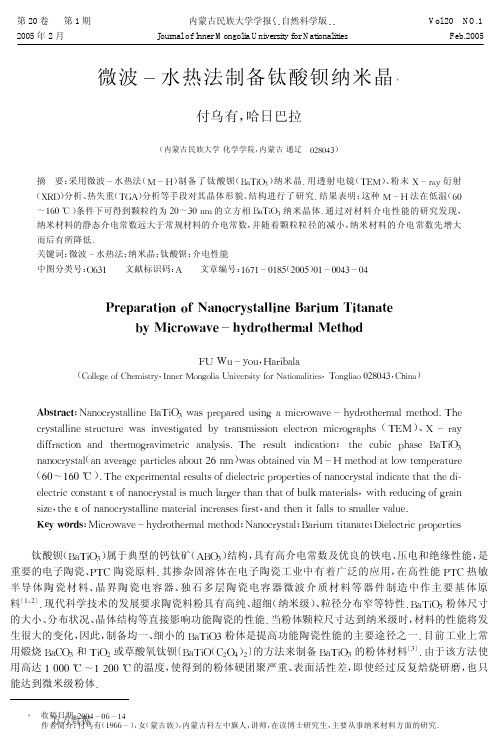
! " # % " % & ’ ( )( *+ % ) ( , " . & % / / ’ ) #0 % " ’ 1 23 ’ & % ) % & # $ 4 ’ , " ( 6 % 7 # !8 9 " ( & 8 # " 2 % /5 # & 8 ( 9 -5 , > ?@ A ! B A ( * 1 , C * D * 2
〔 〕 3 ! 4 行了研究, 此后, 他们用此方法快速合成了多种氧化物陶瓷、 氢氧化物、 多孔材料及粉体材料 指出微 ’
波结合水热法与传统合成法比较, 在许多方面表现出优越特性, 如在微波加热条件下, 瞬间使整体物体温 另外, 它也 度达到结晶化温度, 沉淀凝胶快速溶解然后均匀成核, 并迅速达到过饱和, 缩短了结晶化时间’ 可以节约能量’ 笔者主要研究了在5 利用微波 6 水热法制备出颗粒细小、 粒径分布狭窄 * ! . 5 * +范围内, 的钛酸钡晶体’
!
收稿日期: # " " % ! " 7 ! 8 % 万方数据 作者简介: 付乌有 ( , 女 (蒙古族) , 内蒙古科左中旗人, 讲师, 在读博士研究生, 主要从事纳米材料方面的研究. 8 X 7 7 !)
) )
内
蒙
古
民
族
大
学
学
报
( * * 3年
在纳米 ! 的制备方法中, 水热化学法更有潜力’ 因为以水热化学法不仅得到的粉体产物颗粒细 " # $ % & 在强碱 ( ) 溶液中,水合 # 凝胶与氯化钡反应直接得到立方系的 小, 更重要的是, 在低于( ) *+, -! . & $ % , ( 〔 〕 晶体 ) ’ 然而, 普通的水热法合成 ! 晶体, 晶化时间需要数十个小时甚至几天时间, 这会使纳 ! " # $ % " # $ % & & 因此, 最近人们研究焦点集中在如何缩短在低温条件下得到 米颗粒团聚, 会降低纳米材料的使用性能’ 晶体的晶化时间’ ! " # $ % & 将微波与水热技术结合, 是美国宾州大学的 /’ 并已对几种陶瓷粉体的合成进 / 0 2 2 (年提出的’ 1于.
材料化学实验讲义-钛酸钡粉体的水热合成
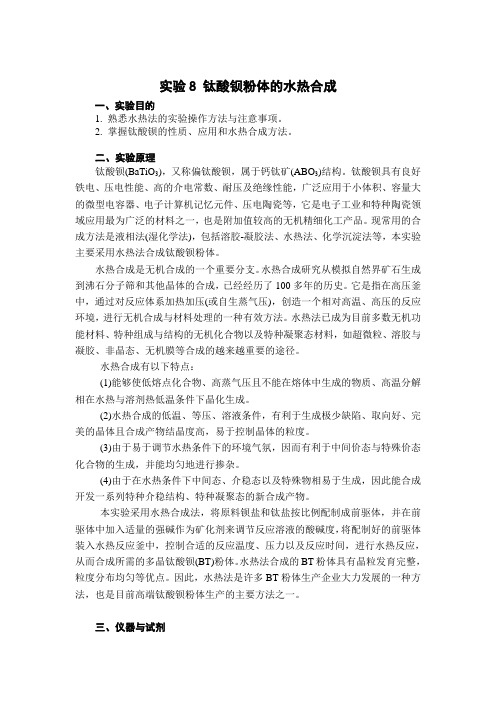
实验8 钛酸钡粉体的水热合成一、实验目的1. 熟悉水热法的实验操作方法与注意事项。
2. 掌握钛酸钡的性质、应用和水热合成方法。
二、实验原理钛酸钡(BaTiO3),又称偏钛酸钡,属于钙钛矿(ABO3)结构。
钛酸钡具有良好铁电、压电性能、高的介电常数、耐压及绝缘性能,广泛应用于小体积、容量大的微型电容器、电子计算机记忆元件、压电陶瓷等,它是电子工业和特种陶瓷领域应用最为广泛的材料之一,也是附加值较高的无机精细化工产品。
现常用的合成方法是液相法(湿化学法),包括溶胶-凝胶法、水热法、化学沉淀法等,本实验主要采用水热法合成钛酸钡粉体。
水热合成是无机合成的一个重要分支。
水热合成研究从模拟自然界矿石生成到沸石分子筛和其他晶体的合成,已经经历了100多年的历史。
它是指在高压釜中,通过对反应体系加热加压(或自生蒸气压),创造一个相对高温、高压的反应环境,进行无机合成与材料处理的一种有效方法。
水热法已成为目前多数无机功能材料、特种组成与结构的无机化合物以及特种凝聚态材料,如超微粒、溶胶与凝胶、非晶态、无机膜等合成的越来越重要的途径。
水热合成有以下特点:(1)能够使低熔点化合物、高蒸气压且不能在熔体中生成的物质、高温分解相在水热与溶剂热低温条件下晶化生成。
(2)水热合成的低温、等压、溶液条件,有利于生成极少缺陷、取向好、完美的晶体且合成产物结晶度高,易于控制晶体的粒度。
(3)由于易于调节水热条件下的环境气氛,因而有利于中间价态与特殊价态化合物的生成,并能均匀地进行掺杂。
(4)由于在水热条件下中间态、介稳态以及特殊物相易于生成,因此能合成开发一系列特种介稳结构、特种凝聚态的新合成产物。
本实验采用水热合成法,将原料钡盐和钛盐按比例配制成前驱体,并在前驱体中加入适量的强碱作为矿化剂来调节反应溶液的酸碱度,将配制好的前驱体装入水热反应釜中,控制合适的反应温度、压力以及反应时间,进行水热反应,从而合成所需的多晶钛酸钡(BT)粉体。
微波水热法制备钛酸锶钡粉体的研究进展
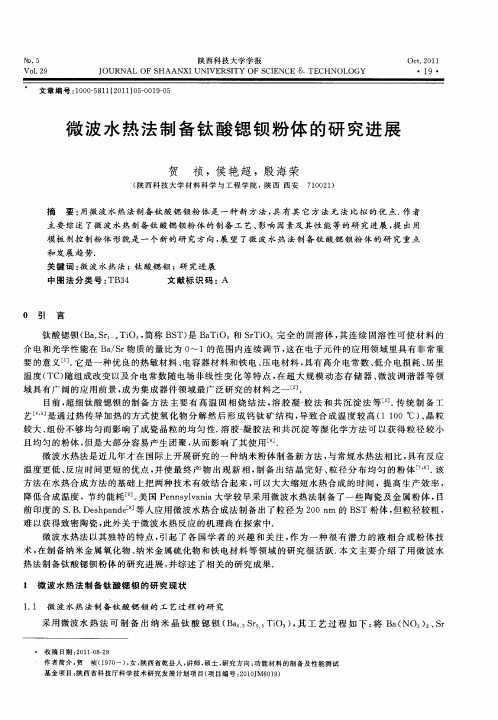
要 的意义 口 . 是 一种优 良的热 敏材 料 、 ]它 电容 器材 料和 铁 电 、 电材 料 , 压 具有 高介 电 常数 、 介 电损 耗 、 低 居里 温度 ( C) T 随组 成改 变 以及介 电常数 随 电场非 线性 变 化 等 特 点 , 超 大规 模 动 态存 储 器 、 波 调 谐 器 等领 在 微 域 具 有广 阔的应 用前 景 , 为集 成 器件领 域 最广 泛研 究 的材料 之 一[ . 成 2 ] 目前 , 细钛 酸锶 钡 的制备 方 法 主要 有 高 温 固相 烧 结 法 , 胶 凝 一 法 和共 沉 淀 法 等_ . 统 制 备 工 超 溶 胶 _ 传 3 ] 艺_ ] 4 是通 过热 传导 加热 的方 式使 氧 化 物分 解 然 后 形 成 钙钛 矿 结 构 , 致 合 成温 度 较 高 ( 0 导 1 1 0℃ ) 晶粒 、 较大 、 组份 不够 均 匀而 影 响 了成 瓷 晶粒 的均 匀 性. 胶一 胶法 和 共 沉 淀 等湿 化 学 方 法 可 以获 得 粒径 较小 溶 凝 且 均 匀 的粉体 , 是大 部分 容易 产 生 团聚 , 而影 响 了其 使用 ] 但 从 . 微波 水热 法是 近几 年 才在 国际 上开 展研 究 的一种 纳 米粉 体制 备新 方 法 , 常规 水热 法相 比 , 与 具有 反应 温度 更低 、 反应 时间更 短 的优点 , 使最 终 产 物 出现 新 相 , 备 出结 晶完 好 、 径 分 布 均 匀 的粉 体 ] 该 并 制 粒 . 方 法 在水 热合 成方 法 的基 础上 把两 种技 术有 效结 合起 来 , 以大 大缩 短水 热合 成 的 时 间 ,提高 生 产效 率 , 可 降低 合成 温度 ,节约 能耗 。 . 国 P n sla i 。美 ] e n yv na大学 较早 采用 微 波水热 法 制备 了一 些 陶瓷及 金 属 粉体 , 目 前 印度 的 S B Deh a d _ 等人 应 用微 波水 热合 成法 制备 出了粒 径为 2 0n 的 B T 粉体 , . . s p n e8 0 m S 但粒 径较 粗 , 难 以获得 致密 陶 瓷 , 外关 于微 波水 热反 应 的机 理 尚在探 索 中. 此
超细钛酸钡粉体的水热合成
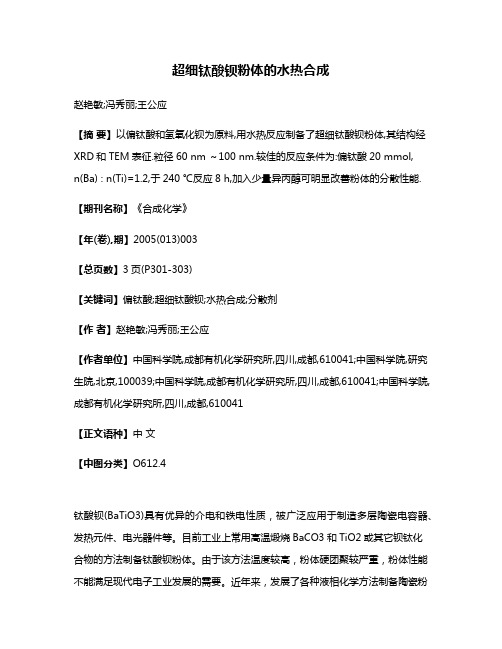
超细钛酸钡粉体的水热合成赵艳敏;冯秀丽;王公应【摘要】以偏钛酸和氢氧化钡为原料,用水热反应制备了超细钛酸钡粉体,其结构经XRD和TEM表征.粒径60 nm ~100 nm.较佳的反应条件为:偏钛酸20 mmol,n(Ba) : n(Ti)=1.2,于240 ℃反应8 h,加入少量异丙醇可明显改善粉体的分散性能.【期刊名称】《合成化学》【年(卷),期】2005(013)003【总页数】3页(P301-303)【关键词】偏钛酸;超细钛酸钡;水热合成;分散剂【作者】赵艳敏;冯秀丽;王公应【作者单位】中国科学院,成都有机化学研究所,四川,成都,610041;中国科学院,研究生院,北京,100039;中国科学院,成都有机化学研究所,四川,成都,610041;中国科学院,成都有机化学研究所,四川,成都,610041【正文语种】中文【中图分类】O612.4钛酸钡(BaTiO3)具有优异的介电和铁电性质,被广泛应用于制造多层陶瓷电容器、发热元件、电光器件等。
目前工业上常用高温煅烧BaCO3和TiO2或其它钡钛化合物的方法制备钛酸钡粉体。
由于该方法温度较高,粉体硬团聚较严重,粉体性能不能满足现代电子工业发展的需要。
近年来,发展了各种液相化学方法制备陶瓷粉体,其中水热法[1]制得的粉体因其结晶度高、团聚少、烧结活性好等优点而受到重视。
以前报道所使用的钛源包括商品化的金红石或锐钛相TiO2,有机钛酸酯、TiCl4等,其中商品化的TiO2活性较差,所需反应时间较长;有机钛酸酯虽活性较高,所得样品性能好但价格昂贵,原料成本高;TiCl4的水解处理过程中产生大量的HCl气体,对环境和操作人员的健康都产生很大的危害。
偏钛酸(H2TiO3)是钛白粉制备的中间体,实际上为二氧化钛的水合物,与有机钛酸酯相比价格较低且易处理。
由于H2TiO3含有少量的硫、铁、铝、锑、钙等金属离子,需进行净化处理。
本文以H2TiO3(用纯水多次洗涤净化)为钛源,用水热合成法制备了超细BaTiO3粉体,其结构经XRD和TEM表征。
水热反应法制备纳米粉体的研究进展

水热合成法由于其具有反应温度低、操作简单、产物纯度高、粒径小等优点, 已经成为制备纳米粉体的重要方法之一。本次演示主要对水热合成法制备钛酸钡 纳米粉体的研究进展进行综述。
3、水热反应:将溶液放入高温高压的密闭容器中,控制反应温度和压力, 使氧化锆和氢氧化钠发生反应,生成纳米二氧化锆颗粒。
4、分离和洗涤:反应结束后,将得到的固体产物用离心机分离出来,并用 去离子水洗涤数次,以去除固体表面的杂质。
5、干燥:最后将固体产物在烘箱中干燥,得到纳米二氧化锆粉体。
谢谢观看
结论:
本次演示介绍了水热反应法制备纳米粉体的基本原理和影响因素,以及其在 制备不同种类的纳米粉体中的应用。水热反应法作为一种常用的制备纳米粉体的 方法,具有环境友好、操作简单等优点。通过控制反应温度、压力、反应物浓度 等参数,可以实现对纳米粉体形貌和尺寸的调控。
制备出的纳米粉体具有优异的物理性能和化学稳定性,适用于各种高要求场 合。未来发展将更加注重水热反应法制备纳米粉体的工业化应用和可持续性发展 等方面的研究。
适当的添加剂可以调节溶液的离子强度、PH值等参数,从而影响化学反应的 过程和产物的形貌。此外,添加剂还可以起到稳定剂、分散剂等作用,有助于提 高纳米粉体制备的稳定性和分散性。
水热反应法在制备不同种类的纳米粉体中的应用:
1、金属氧化物
金属氧化物是常见的纳米粉体材料之一,具有广泛的应用前景。水热反应法 在制备金属氧化物纳米粉体中具有较高的优势。例如,水热反应法可以制备出高 质量的二氧化钛、氧化锌、氧化铁等金属氧化物纳米粉体。通过控制反应温度、 压力、反应物浓度等参数,可以实现对纳米粉体形貌和尺寸的调控。
制备纳米钛酸钡粉体

制备纳米钛酸钡粉体化学共沉淀法——制备纳米钛酸钡粉体目录 ..................................................................... ...........................(1) 成绩考评表...................................................................... ......................(2) 中文摘要...................................................................... .........................(3) 英文摘要...................................................................... ..........................(4) 1前言...................................................................... ...............................(5) 1 .1制备方法介绍...................................................................... . (6)1.2所制备的材料介绍...................................................................... . (9)1.3本实验主要研究内容....................................................................(1 2)2.实验实施阶段2.1方案介绍...................................................................... (13)15) 3实验结果分析与 2.2方案具体实施...................................................................... ..........(讨论...................................................................... .(17) 参考文献...................................................................... (22)综合实验感想...................................................................... . (23)BaTiO3纳米粉体的制备摘要以TiCl4为钛源,BaCl2为钡源,采用草酸共沉淀法制备batio3粉体,研究了前驱体的煅烧温度对产物的影响,实验结果表明当煅烧温度控制在800度以上时,可制的纯度高结晶好的batio3超细粉体。
- 1、下载文档前请自行甄别文档内容的完整性,平台不提供额外的编辑、内容补充、找答案等附加服务。
- 2、"仅部分预览"的文档,不可在线预览部分如存在完整性等问题,可反馈申请退款(可完整预览的文档不适用该条件!)。
- 3、如文档侵犯您的权益,请联系客服反馈,我们会尽快为您处理(人工客服工作时间:9:00-18:30)。
第42卷第11期人工晶体学报Vol.42No.112013年11月JOURNAL OF SYNTHETIC CRYSTALSNovember ,2013微波水热合成钛酸钡纳米粉体陈杰,闫峰,罗昆鹏(西安科技大学材料科学与工程学院,西安710054)摘要:采用微波水热法低温合成了立方相钛酸钡纳米粉体。
通过正交实验法及线性回归,研究了反应温度、反应时间及分散剂用量等因素对颗粒比表面积的影响规律及回归函数,并通过XRD 、TEM 、XRF 等对粉体进行了表征。
研究结果表明,在反应温度70ħ、反应时间10min 、分散剂与钛的物质的量比为1ʒ20的条件下制得粒径约50 100nm 、呈球状的分散性良好的立方相钛酸钡纳米粉体。
反应温度、反应时间及分散剂用量对粒度均有不同程度的影响,其中反应温度影响最为显著。
关键词:微波水热法;钛酸钡纳米粉体;正交实验法;线性回归中图分类号:TM282文献标识码:A文章编号:1000-985X (2013)11-2359-05Synthesis of BaTiO 3Nano-powder by Microwave Hydrothermal MethodCHEN Jie ,YAN Feng ,LUO Kun-peng(School of Materials Science and Engineering ,Xi'a n University of Science and Technology ,Xi'a n 710054,China )(Received 12May 2013,accepted 13September 2013)Abstract :Cubic phase barium titanate nano-powders were synthesized under low temperature by microwave-hydrothermal method.The influence law of factors such as reaction temperature ,reaction time ,and the dispersant dosage on the specific surface area of particles and regression function were studied by the orthogonal experiment method and linear regression.The crystallized products were characterized by powder X-ray diffraction (XRD ),transmission electron microscopy (TEM ),X-ray fluorescence (XRF ).The experimental results showed that the spherical and well-dispersed cubic phase barium titanate nano-powders which particle size is about 50-100nm could be prepared under the conditions that the reaction temperature is 70ħ,and the reaction time is 10min ,and mole ratio of dispersant and titanium is 1ʒ20.Reaction temperature ,reaction time ,and the dosage of dispersant have different effect on the specific surface area of particles.Among these factors ,the significant factors is reaction temperature.Key words :microwave hydrothermal method ;BaTiO 3nano-powder ;orthogonal experiment method ;linear regression收稿日期:2013-05-12;修订日期:2013-09-13基金项目:国家自然科学基金(51072162)作者简介:陈杰(1967-),女,陕西省人,教授,博士。
E-mail :chenjie363@163.com 1引言钛酸钡(BaTiO 3)是一种强介电材料、压电材料和铁电材料,广泛应用于电容器、PTC 组件、压电换能器等电子元器件的制造,是一种用途广泛的重要电子陶瓷材料。
近年来,随着电子元器件的微型化、小型化、薄2360人工晶体学报第42卷层化发展趋势,纳米尺寸的钛酸钡粉料就成为钛酸钡介质瓷料发展的必然趋势[1]。
目前国内外对高纯、超细BaTiO3粉体合成方法的研究十分重视[2]。
钛酸钡粉体的主要制备方法有固相法、溶胶凝胶法、水热法、直接沉淀法、低温燃烧法、草酸盐共沉淀法等[3-10]。
草酸盐沉淀法是目前工业上最为普遍应用的一种制备方法,但需要在1000ħ以上进行热分解来制备钛酸钡,难以制得小粒径粉体。
美国宾州大学的Roy于1992年提出微波水热合成法,是将传统的水热合成法与微波场结合起来的一种有应用潜力的方法。
与传统的水热法相比,具有加热速度快、反应灵敏、体系受热均匀等特点,可以快速制备形貌均一的超细粉体。
如今,微波水热法已对多种纳米粉体的合成进行了研究,引起国内外广泛重视[11,12]。
微波水热法合成产物颗粒的大小、形貌等与反应温度、反应时间、反应物浓度、分散剂的种类及用量密切相关。
因此,探索合适的微波水热合成条件对研究控制粉体的形貌及大小有着重要的意义。
本文采用廉价的钛酸四丁酯、硝酸钡为原料在低温常压下合成出BaTiO3粉体。
利用正交实验法,研究了反应温度、反应时间、分散剂的用量对粉体比表面积的影响,获得微波水热合成的最佳合成条件,并利用回归分析对结果进行检验。
2实验2.1粉体制备选用分析纯的钛酸四丁酯、硝酸钡、氢氧化钠为实验原料,以OP-10为分散剂,准确配制2mol/L的NaOH溶液,加热至80ħ除去其中溶解的CO。
量取一定量的NaOH溶液于反应容器中,在磁力搅拌下逐滴2滴加钛酸四丁酯溶液,然后加入等量的Ba(NO3)2溶液,按确定的比例加入分散剂,控制反应溶液的pH>13。
充分搅拌后,移入上海新仪微波化学科技有限公司的MAS-3普及型微波炉中进行加热。
到设置的温度点时开始计时,反应完成后,静置,酸洗,水洗,醇洗后过滤,然后在60ħ干燥4h得到BaTiO3粉体。
2.2实验方法在微波水热法合成钛酸钡粉体的过程中,反应温度、反应时间、分散剂用量是影响钛酸钡粉体粒度的主要因素。
利用正交实验法分析反应温度、反应时间、分散剂的用量等对粉体粒度的影响。
根据颗粒的大小与比表面积的关系,选取比表面积值作为考核值(越大越好)。
考察三个因素反应温度、反应时间、分散剂用量,每个因素考察三种状态,即反应温度(90ħ,80ħ,70ħ);反应时间(30min,20min,10min);分散剂用量(以分散剂与钛的物质的量比来衡量分散剂的用量,即N OP-10ʒN Ti=1ʒ10;1ʒ20;1ʒ30)。
实验采用三因素三水平正交设计安排实验,因素水平表见表1。
表1因素水平表Table1Factor and level of experiment parametersFactor Synthesis temperature/ħSynthesis time/min Dispersant dosageLevel190301ʒ10Level280201ʒ20Level370101ʒ302.3测试与表征采用美国麦克公司2020型物理吸附仪测试颗粒的比表面积;利用日本理学公司的D/MAX-2004型X 衍射仪对粉体做X衍射定性分析(Cu Kα靶,扫描波长为0.15405nm);使用日本电子的JEM-200CX透射电子显微镜观察粉体的分布、颗粒大小与形貌。
采用德国Bruker公司的S4Pioneer-X荧光光谱仪测试粉体中的杂质含量。
3结果与讨论3.1正交试验结果分析正交试验结果的均值分析可以找到各因素分别取何值时所得到的实验结果会最好,极差分析可以了解第11期陈杰等:微波水热合成钛酸钡纳米粉体2361各影响因素的主次顺序。
正交试验的正交结果如表2所示。
根据考核值比表面积越大越好,从表2的均值中可以看出,较好参数为T=70ħ,t=10min,n=1ʒ20。
极差表明因子对结果的影响程度,根据极差值的大小,可知各因素的影响程度。
利用极差分析各因素的影响主次顺序为反应温度>反应时间>分散剂用量。
直观分析虽然可以大致估计各因素的作用效果强弱,但不能估计实验过程及实验结果测定中必然存在的误差大小,不能区分某因素各水平所对应的实验结果间的差异是因素水平不同,还是实验误差所引起,所以不能得知分析的精度。
为此,再对实验结果进行回归分析进行检验和修正。
表2正交试验结果Table2Results of orthogonal experimentFactorReaction temperature/ħReaction time/min Dispersant dosage Specific surface area/m2·c.c.-1Test190301ʒ107.94Test290201ʒ207.66Test390101ʒ308.19Test480301ʒ207.97Test580201ʒ3010.54Test680101ʒ1010.59Test770301ʒ308.02Test870201ʒ1011.22Test970101ʒ2011.61Mean17.937.9779.917Mean29.709.8079.080Mean310.28310.1308.917Range2.3532.1531.0003.2回归方程的检验设有回归方程:Y=α+β1X1+β2X2+β3X3(1)方程中自变量X1,X2,X3分别为正交设计中的温度、时间和分散剂用量的观察值;因变量Y为比表面积的测量值。
将表2的数据代入(1)式,经spss软件运算得出回归系数,如表3所示。
表3回归系数表Table3Coefficient of regressionαβ1β2β3 19.936-0.118-0.10815.335所以回归方程为:Y=19.936-0.118X1-0.108X2+15.335X3,利用方差分析回归方程的显著性,方差分析表见表4所示。
